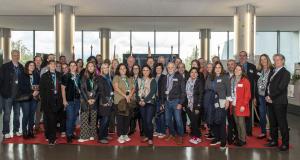Visit
California lawmakers and environmentalists explore ITER
30 Oct 2023
Members of the California Foundation on the Environment and the Economy (CFEE) travel the world to study the most significant initiatives in terms of environmental preservation and innovation.
On Tuesday 24 October, ITER became the latest study destination for members of the California Foundation on the Environment and the Economy (CFEE). Eight state senators and four lawmakes from the lower house were among them.
A journey to Sweden and Norway to examine advances in carbon capture and storage. To Iceland, to study geothermal energy production. To Japan, to understand the emergence of high-speed rail projects. To Australia, to explore best practices in transportation infrastructure and water resource management. To the Netherlands, to learn about floodwater management. On Tuesday 24 October, ITER became the latest study destination for this singular group composed of California state legislators (8 from the Senate, 4 from the lower house) and representatives from public utilities, oil and gas companies, renewable energy producers, trade unions, manufacturing, and the California Energy Commission. Leading the group of 38 was Jay Hansen, the president of CFEE and a long-time environmental advocate and strategist who has made it his mission to show leading influencers what can be done to fight climate change and promote positive change.
Being Californians, the group was well aware of the latest advances in fusion, such as the recent breakthrough at NIF, located in northern California, or the contribution to ITER from San Diego-based General Atomics.
Being Californians, the group was well aware of the latest advances in fusion, such as the recent breakthrough at the National Ignition Facility (NIF), located to the east of the San Francisco Bay at the Lawrence Livermore National Laboratory, or the contribution to ITER from San Diego-based General Atomics. During the presentation by ITER Head of Communication Laban Coblenz and all through the site visit, the questions were many and to the point: What is fusion's timeline to commercialization? How to develop the interactions of public and private fusion initiatives? What is the economic outlook for fusion? And a final question: how can individuals with their varied backgrounds help support fusion research?



